 |
VA-82 Marauders- 1972 Vietnam Deployment January 1972- December 1972 (Updated November 1st, 2021) |
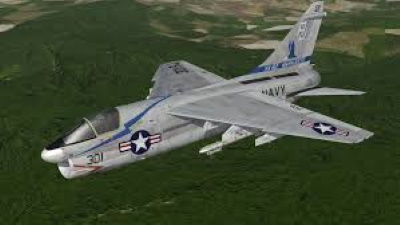 |
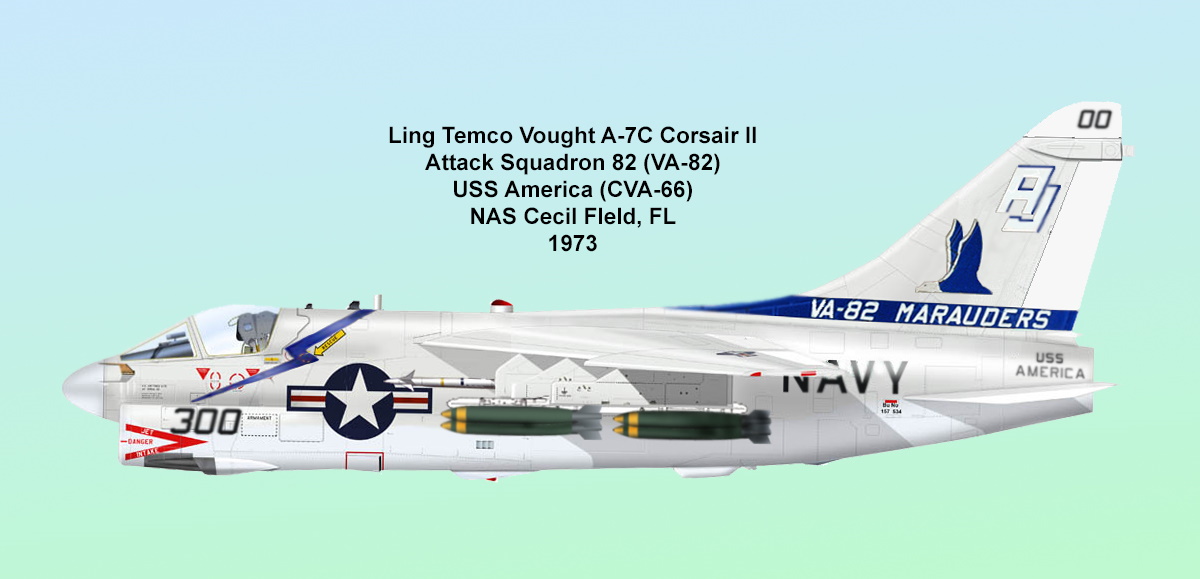 |
We took a break for the holidays after the fly in from our Med cruise on December 15th, 1971.
 |
| Heather
(8), Laura (6) |
It was wonderful to spend some time with our families. I especially enjoyed seeing my 5 month old daughter Stacy
for the first time and having our entire family together.
I think we made a Christmas trip to New Jersey and Duxbury and then returned to Jacksonville in early January.
January, 1972
I flew 14 flights in January (25.7 total jet hours) (18.8 A7E hours)
Ten of these were A7 flights with VA-82, mostly instrument flights including some night time.
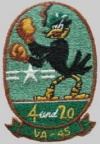 |
Four of the flights were instrument flights in the TA-4 flights with VA-45
(6.9 TA-4 hours) |
We had a lot of pilot changes at the end of the Med cruise after we got back.
VA-82 Officers March, 1972
We added three new pilots in March; Lt Dan Rather, the CAG 8 LSO would fly regularly, LT Bob Corey, and Ltjg Steve Musselman joined us from the RAG.
We now had our complement of 18 squadron pilots and one pilot who would fly with us regularly from at Air Wing.
| Top Row (left to Right): WO1 John Young,
LT Phil Morris, Ltjg Tom Weiland, LTjg Steve
Musselman, LT Bob Corey, LT Craig "Crash" Landon, LT
Ray Thomas, LTjg Marv Baldwin, LTjg Jim Kuzmick, LT Ron Brooks, Ltjg Jim Brister, LT Dan Ryder (CAG 8 LSO), Ens Nick Nickens and CWO2 Hal Garrett Front Row: LT Jim "Rock" Yeager, LT Gary Tabbert, LCDR Bruce Page, me, CDR Don Sumner (CO), CDR Tom Scott (XO), LCDR Leighton "Snuffy" Smith, LCDR Al Miller, LT Charlie Sapp |
We had 18 pilots assigned to the squadron and Lt Dan Rather who was the CAG 8 LSO and flew regularly with us.
We had a"brand new" Air Intelligence Officer, Ens Strain who I almost never saw because he was basically assigned to the CAG Eight.
We had no dedicated Flight Surgeon as by then he flight surgeons were attached to the airwing.
My key Maintenance Officers were:
Lt Phil Morris (Maintenance Control), Ens Nick Nickens (Mintenance/Material Officer), and AVCM Jim Moorehead (Maintenance Control Chief)*
*Master Chief Moorehead was the finest Maintenance Control Chief I served with during my Navy career!
We had two Warrant Officers in Maintenance supervisory positions; CWO2 Hal Garrett and WO1 John Young
February, 1972
I flew only 8 flights in January (12.1 A7E hours)
Most of the flights seem to be instrument or basic formation flights; all day flights. There are no indications that any of these were weapons flights.
I can only guess that we were at the bottom of the "totem pole" for fuel money and were saving fuel dollars for March to get ready for type training on the America in April.
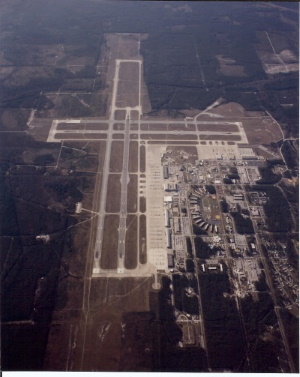 |
We had some challenges ahead of
us to get ready for type training. Of course both the CO and XO were experienced carrier jet pilots. I don't know whether Don Sumner had any Vietnam combat experience but CDR Scott did flying A4 Skyhawks with VA-195 "Dambusters" on the "Bonnie Dick" AKA, the Bonne Home Richard CV-31 in 1965 and with the VA-113 "Stingers" on USS Kitty Hawk in 1966. Snuffy and I were the only qualified combat strike leaders in the second tour group. The other two LCDRs, Bruce Page and Al Miller were experienced pilots but without any combat experience. LT Charlie Sapp had just completed jet transition training but had a combat tour with Light Attack Squadron Four VAL-4 flying OV-10s in the Mekong Delta. Charlie had over 200 close air support missions in VAL-4. Three of our second tour JOs from the Med cruise; Ray Thomas, Rock Yeager and Gary Tabbert were strong. A new pilot, Crash Landon had flown F8 Crusaders in a VC squadron so was an relatively experienced pilot but without much carrier operational experience. |
President Nixon's Visit to China from February 21st through the 28th,1972
President Nixon's visit
to China changed the balance of power in Asia. China was
less interested in helping out their neighbor to the south
and more interested in not jeopardizing their improving
relationship with the USA. President Nixon left the visit
confident that China would not intervene if the US decided
to increase the bombing of North Vietnam. The tide had
turned completely from a President and Secretary of
Defense who were afraid to apply too much military
pressure on North Vietnam for fear of China entering the
war (Johnson and MacNamara) to a President and his
National Security Advisor who were not afraid to turn up
the pressure on North Vietnam (Nixon and Kissinger).
March,
1972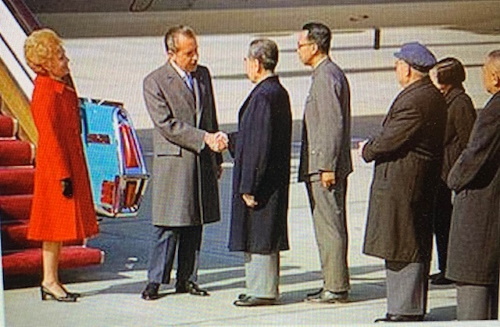 President
and Mrs. Nixon are met by Chinese Premier Zhou
Enlai upon their arrival in Beijing.
|
I flew 16 flights in March (27.0 A7E hours)
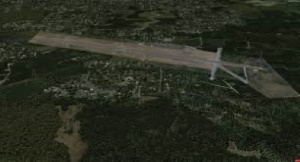 |
From
the beginning of March through March 21st we continued
with flights around Cecil field; still no indications
in my log book of any weapons work. On March 23rd, we began night FCLPs at Whitehouse. I logged 35 night FCLPs on four flights at the end of March. |
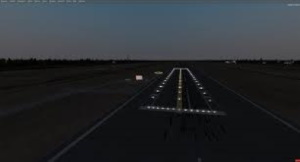 |
The Nguyen Hue Offensive- March 30th,1972
At
noon on 30
March, 1972
30,000 North
Vietnamese
Army (NVA)
troops,
supported by
regiments of
tanks and
artillery,
rolled
southward
across the
Demilitarized
Zone (DMZ)
that separated
North and South
Vietnam. This
three division
force caught the
Army
of the
Republic of
Vietnam (ARVN)
and their
American
advisors unprepared.
The NVA
force struck the positions of
the ARVN 3rd
Division and
threw it into
disarray. The
South
Vietnamese
forces fell
back, and a
race began between
both sides to
the bridges at
Dong Ha and
Cam Lo in I
Corps.
President Nixon's first response was to consider a three day attack by B-52 bombers on Hanoi and Haiphong. However Henry Kissinger convinced him to reconsider, in order not to jeopardize the formulation of the SALTY I Treaty with the Soviets that was due to be signed in May.
We were
scheduled for
another Med
cruise. But,
things were
going to
change for us in a
big way.President Nixon's first response was to consider a three day attack by B-52 bombers on Hanoi and Haiphong. However Henry Kissinger convinced him to reconsider, in order not to jeopardize the formulation of the SALTY I Treaty with the Soviets that was due to be signed in May.
With President Nixon in the White House, our national policy was to increase the pressure on the North Vietnamese by increasing our aircraft carrier presence on Yankee Station.
The result for us was that we were directed to transfer 12 A7Es and replace them with 12 A7Cs and deploy to Yankee Station in June instead of the Mediterranean!
The basic difference between the A7E and the A7C was the engine.
The A7E had the Allison TF-41 engine (14,250 lbs thrust). The A7C had the Pratt & Whitney TF30-P-408 engine (14,560 lbs thrust)
April, 1972
I flew 22 flights in April (35.1 hours)
2 A7E flights (3.7 hours), 19 A7C flights (29.8 flight hours) , and 1 TA4 flight (1.6 hours)
I logged 16 America traps (10 day, 6 night) for a cumulative total of America traps of 134.
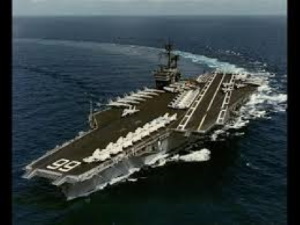 |
We
had very little time to FCLP in the A7C before flying
out to the America for type training. I had one FCLP
flight to check out the difference in the TF30-P-408
throttle response while making glide path adjustments
on the ball. I flew out to America and made two day traps and then turned around for my night quals and made 2 night traps. I ended up flying 18 type training flights from America in April. Two of these flight involved landings at Cecil. So, I logged 16 traps (10 day, 6 night) in April for a total of 134 America traps. We continued what would turn out to be one continuous two month type training period in May. My logbook doesn't indicate the types of flights. But, we certainly were very proficient in the CAG 8/America standard operating procedures day and night by the end of May. |
May, 1972
I flew 16 A7CF flights in May (28.8 hours)
I logged 14 America traps (11 day, 3 night) for a cumulative total of America traps of 148.
June, 1972
Another big surprise!
On June
2nd, Admiral
Elmo R.
Zumwalt, the
Chief of Naval
Operations,
visited the
America and
explained why
the ship's
orders had
been changed
from a cruise
to the
Mediterranean
to a combat
deployment to
Vietnam.
President
Nixon had
decided to
increase the
pressure on
the North
Vietnamese by
extending air
combat
missions from
the
limitations of
President
Johnson's 's
bombing
halt.
This
presidential
initiative
called
Operation
Linebacker I
required four
aircraft
carriers on
Yankee Station
simultaneously.
As a result,
USS Midway CVA
41, USS
America CVA
66, and USS
Saratoga
CVA-60 would
be ordered to
join USS Kitty
Hawk CVA 63
and USS
Constellation
CVA 64 in the
Tonkin Gulf so
that four
carriers could
be on station
at one time.
This change in mission required that I had a lot to do as Maintenance Officer in the short time we had before deployment. The Maintenance Control Officer, Phil Morris and the Maintenance Control Chief, Master Chief Jim Moorehead had done a great job in getting the required technical manuals and parts bulletins (IPBs) necessary to accomplish the maintenance of our A7Cs. We had had two months to adjust to the TF30-P-408 engine. There were still some jet engine mechanics around who had been with the squadron's 1970 deployment to WESTPAC flying the A7Bs with the same engine. The avionics systems were basically the same in both aircraft. But, we had two major challenges. First, to make sure that our electronic warfare (EW) personnel were up to snuff in the maintenance and use of the EW test equipment which would be critical for a Tonkin Gulf combat cruise.
(This
was paraphrased
from a Wikipedia
discussion of
Linebacker One)
This change in mission required that I had a lot to do as Maintenance Officer in the short time we had before deployment. The Maintenance Control Officer, Phil Morris and the Maintenance Control Chief, Master Chief Jim Moorehead had done a great job in getting the required technical manuals and parts bulletins (IPBs) necessary to accomplish the maintenance of our A7Cs. We had had two months to adjust to the TF30-P-408 engine. There were still some jet engine mechanics around who had been with the squadron's 1970 deployment to WESTPAC flying the A7Bs with the same engine. The avionics systems were basically the same in both aircraft. But, we had two major challenges. First, to make sure that our electronic warfare (EW) personnel were up to snuff in the maintenance and use of the EW test equipment which would be critical for a Tonkin Gulf combat cruise.
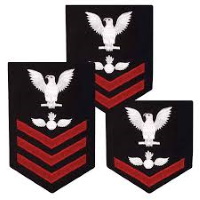 |
Second, our biggest problem was that we didn't have nearly enough aviation ordnancemen assigned to the squadron. We had about 14. But, we would need almost twice that number for Linebacker One operations on Yankee Station. Our Commanding Officer Tom Scott "gresaed the skids" with the Latwing and the CO, of VA-174 so I could work directly with te Maintenance Officer at VA-174 to see if we could work something out. I knew that Navy ordnancemen would jump at the chance to join us if they had the opportunity. It wasn't so much for the combat pay. It was more about actually doing what they were trained to do. It turned out, I was right. We had ten more ordnancemen within the week. We deployed with about 24 ordnancemen. |
June, 1972
I flew only 4 in June (7.0 hours)
I logged 3 America traps (2 day, 1 night) for a cumulative total of America traps of 151.
I flew an A7C from Cecil t NAS Norfolk for the aircraft load aboard.
America got underway on June 5th, 1972 for our WESTPAC Vietnam Deployment
I flew three flight from America; June 8th, 15th, and 18th as the ship was transiting the Atlantic Ocean.
The Transit Route
 |
| America's transit route
would take us southeast toward Capetown, South
Africa via the Cape of Good Hope then
northeast through the southern Indian Ocean through the Maldives and the Straits of Malacca then north north east to Subic bay Philippines for a short stop then out to the South China Sea to Yankee Station. |
Crossing the Equator
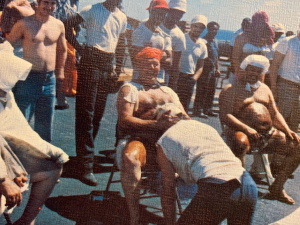 |
Our transit route meant that we would cross the Equator twice during our transit; first in the Atlantic going southeast in the South Atlantic Ocean off the coat of North Africa and next in the Indian Ocean enroute to the Straits of Malacca. The Atlantic crossing provided the best opportunity to celebrate the crossing of the Equator as us Shellbacks would indoctrinate the lowly Pollywogs to the World of King Neptune. |
COD Landing Incident Cape Town, South Africa
As the America was rounding the Cape of Good Hope, the ship's COD flew in to Cape Town to pick up some mail and critical parts.
Upon landing, the COD drifted from port to starboard with it's right wing crossing the foul line impacting the tails of several A7s parked there.
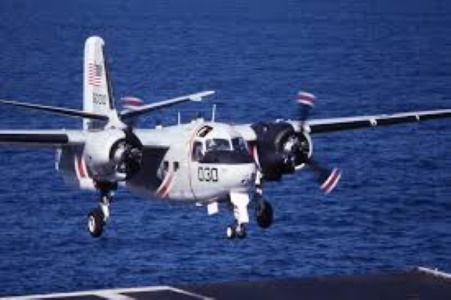 |
 |
I was in our ready room relaxing and happened to glance at the CCTV as the COD's wing impacted four or five A7 tails.
As Maintenance Officer of the squadron, I was shocked as I watched one rudder after another shatter.
Then I noticed that all of the rudders had red diamonds on them, all VA-86 aircraft. I felt bad for them but I must admit, I was glad they were not ours.
I think our metal smiths (AMS) helped the VA-86 guys. In most cases, the repairs were limited to replacing the rudders.
America's transit took about 33 days from Norfolk on June 5th until she arrived
At NAS Cubi Point on about July 7th
There was a lot to do besides holding crossing of the Line festivities!
 |
I used some of the time to continue with my ship training with an eye to someday getting my own ship. The ship scheduled time for those of us so interested to observe along side replenishment events from the bridge wing. I also spent more time in the boiler and engine rooms refreshing my ship engineering knowledge. |
I also made a suggestion to the CO, XO, and Snuffy that we consider removing the inboard weapons stations (3 and 6) from our A7Cs.
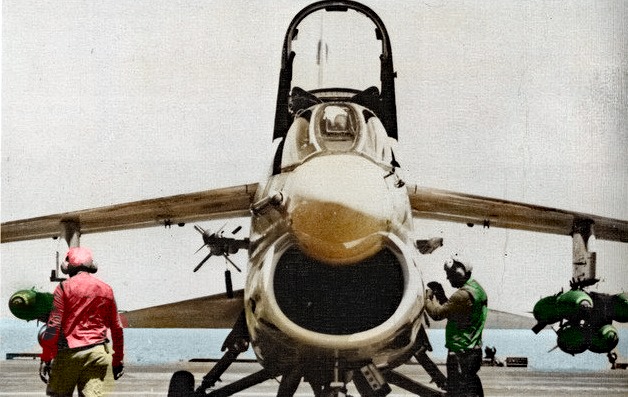 |
Our A7C's had a weight restriction of 500 lbs (one MK 82 bomb) on weapons stations (3 and 6) due to center of gravity factors with the A7C TF30-P-408 engine. I felt that we should remove stations 3 and 6 from our aircraft because the reduced drag would increase our top end airspeed which would be more important in Linebacker One Operations over North Vietnam than losing two MK 82s from our bomb load. |
The CO, XO, and Snuffy agreed. So our maintenance guys set to work to reconfigure the aircraft
and have them all checked out prior to arriving at Cubi Point in the Philippines.
Our next and most important task was to conduct ground training for our pilots
in squadron standard operating procedures in the North Vietnam tactical combat environment.
A Brief Overview of Linebacker One
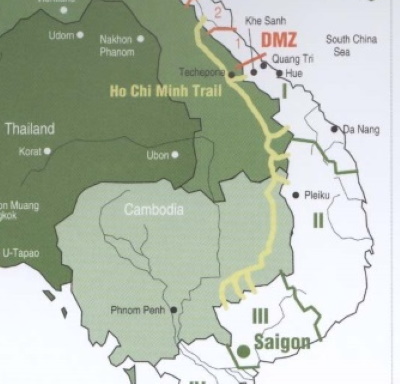 |
The purpose of Linebacker One was to slow the transportation of supplies and materials for the North Vietnamese Nguyen Hue Offensive that had been launched on March 30th. This offensive consisted of three North Vietnamese operations that were launched that spring. On March 30th , 300,000 North Vietnamese troops (NVN) supported by regiments of tanks and artillery rolled south across the Demilitarized Zone (DMZ). On April 5th, a force of 20,000 NVN troops crossed the border from their sanctuaries in Cambodia in a combined arms force to attack Binh Long Province north of Saigon. The third attack came from Laos on April 12th, seizing a series of border outposts in the Central Highlands. |
(This next section is paraphrased from a Wikipedia discussion of Linebacker One)
On April 4th, 1972, President Nixon authorized the bombing of all of North Vietnam North Vietnam which had been previously limited to reprisal raids just above the DMZ up to the 18th parallel.
Linebacker One was the first continuous bombing effort conducted against North Vietnam since the end of Rolling Thunder in November 1968.
The U.S. began a rapid build up of air power.
The USAF Tactical Air Command deployed 176 F4D Phantoms and an additional squadron of F-05 Thunderchiefs from Korea to Thailand.
The USAF Strategic Air Command (SAC) deployed 124 B-52s from the states to Guam bringing the total B-52 strength to 209.
The Navy augmented the USS Kitty Hawk and USS Constellation which were already in WESTPAC by ordering USS Midway from the west coast, and USS America and USS Saratoga from the east coast to deploy to WESTPAC. This added three more carrier air wings to the force and increased the number of ships from 84 to 138.
Linebacker One would have four objectives:
To isolate
North Vietnam
from its
outside
sources of
supply by
destroying
railroad
bridges and
rolling stock
in and around
Hanoi and
northeast to
the Chinese
border; to
target primary
storage areas
and marshaling
yards; to
destroy
storage and
trans-shipment
points;
and to eliminate (or at least damage) the North Vietnamese air defense system.
Air Force and Navy commanders and pilots were relieved that President Nixon, unlike President Johnson, left the operational planning to local commanders and loosened targeting restrictions that had hampered Operation Rolling Thunder in 1966 through 1968.
However, there were still target restrictions. Bombing of the North Vietnam's dike system was still off limits, bombing of third country ships in Haiphong Harbor was still off limits unless specifically approved, and bombing of non military targets downtown Hanoi and Haiphong was off limits.
But, targets that were now open to attack at the local commander level were;
mining of Haiphong harbor and nearby harbors and military targets in Hanoi and Haiphong.
and to eliminate (or at least damage) the North Vietnamese air defense system.
Air Force and Navy commanders and pilots were relieved that President Nixon, unlike President Johnson, left the operational planning to local commanders and loosened targeting restrictions that had hampered Operation Rolling Thunder in 1966 through 1968.
However, there were still target restrictions. Bombing of the North Vietnam's dike system was still off limits, bombing of third country ships in Haiphong Harbor was still off limits unless specifically approved, and bombing of non military targets downtown Hanoi and Haiphong was off limits.
But, targets that were now open to attack at the local commander level were;
mining of Haiphong harbor and nearby harbors and military targets in Hanoi and Haiphong.
There were some changes to the North Vietnamese air defense system that would affect our tactics.
For the fighter pilots: The were many more MIG 21s and MIG 19s around and fewer MIG 17s!
For the Attack Pilots: The North Vietnamese had added many more 37/57/85 mm AAA guns and trained gun crews including the Soviet ZSU 23-4 to its air defense system! The Soviets had provided training for the SAM batteries in new techniques which included multiple site engagements,
track-on-jam, optical tracking, and high-low engagements which improved their effectiveness.
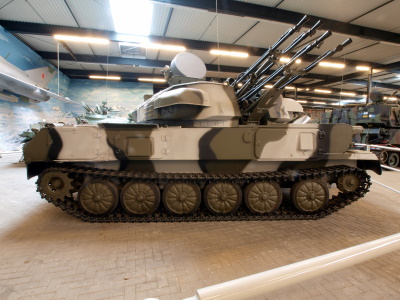 |
The North
Vietnamese
still had
small arms,
manual barrage
fire 37mm and
57 mm AAA,
radar
controlled
57/85/100mm
AAA (firecan,
flapwheel
etc), and the
SA-2
SAMs.
The SAMs were
no longer deployed
in established
sites
but were
better dispersed and
camouflaged. A big change was the deployment of many ZSU quad mounted, radar controlled, mobile 23mm Soviet systems pictured here. This weapon was a game changer! Iron Hand (anti SAM) aircraft could no longer orbit a SAM site at 12,000 feet waiting for the site to launch and then shoot a Shrike "down the throat". The ZSU 23 would pick you off at those altitudes. Its tracers were a rope of 23mm death. Iron Hand aircraft would have to launch their Shrikes into a "basket" from some distance from the target. Strike aircraft would avoid the ZSU 23 by keeping the ingress altitudes above the ZSU 23 effective range. Strike aircraft would only be vulnerable to MIGs, SAMs, and radar controlled 85/100mm at 18,000 or so. |
The Chain of Command for the Carrier Division Ten/USS America/Carrier Air Wing Ten Team
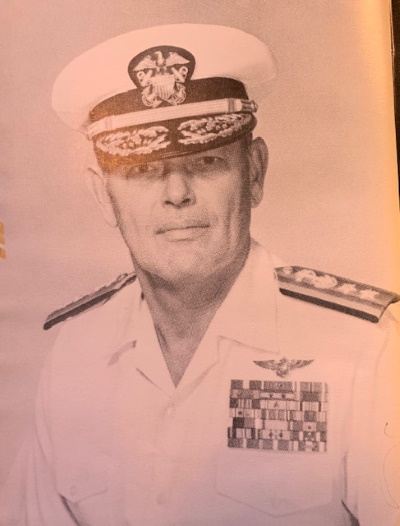 |
Commander Carrier Division Seven Rear Admiral John S. Christiansen
Combat Pilot During WW2 and Korea Navy Cross Distinguished Flying Cross |
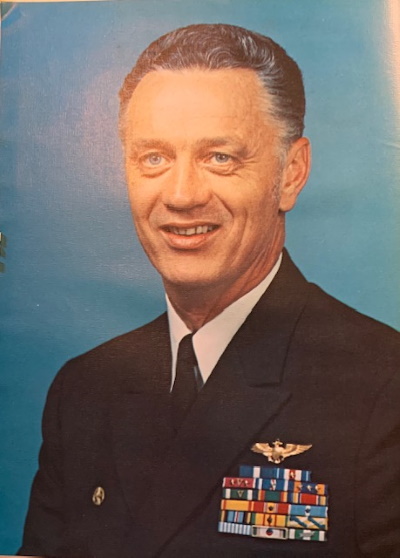 |
Commanding Officer USS America CVA 66
Captain Burton H. Shepherd Fighter Pilot During Korea
CAG 16 USS Oriskany 1967 Vietnam Navy Cross Two Silver Stars Six Distinguished Flying Crosses Eight Air Medals CO VA-81 (A4 Skyhawks)
|
 |
The Admiral and the Captain
were experienced combat veterans who understood what we would be facing in executing Linebacker One |
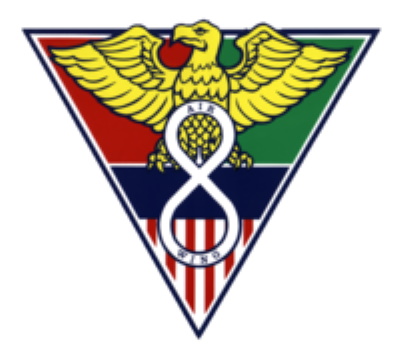 |
Carrier Air Wing Eight
VF 74 Be-Devilers (F4J Phantoms)
VFMA 333 Shamrocks (F4J Phantoms) VA-82 Marauders (A7C Corsairs) VA-86 Sidewinders (A7C Corsairs) VA-35 Black Panthers (A6A Intruders) RVAH 6 Fleurs (RA5C Vigilantes) VAQ 132 Scorpions (EA6B Prowlers) VAW 124 Bullseye Hummers (E2C Hawkeyes) HC 2 Det 66 (SH3G Rescue Helicopters) |
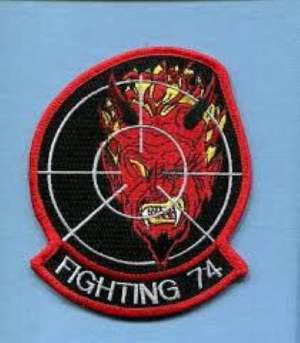 VF 74 Be-Devilers
|
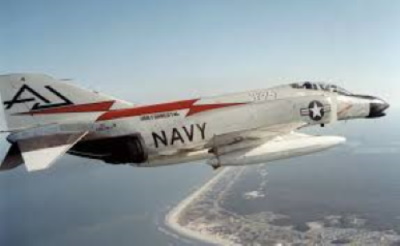 F4J Phantoms |
| VF-74 was
primarily interested in only the air to air mission.
But they did fly some Flak suppression missions. |
|
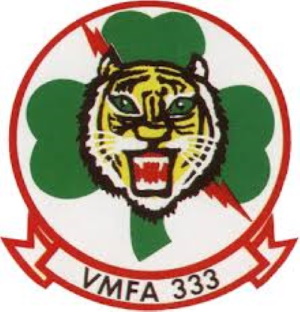 VFMA 333 Shamrocks
|
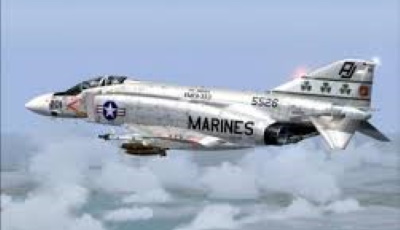 F4J Phantoms |
| The Shamrocks
were trained for and were enthusiastic about
participating in ground attack missions such as flak
suppression and air to ground bombing especially Close
Air Support |
As a result,
the Shamrocks were more valuable to the air wing
because they were interested in and were capable of
being assigned bombing missions and strike support
flak suppression. |
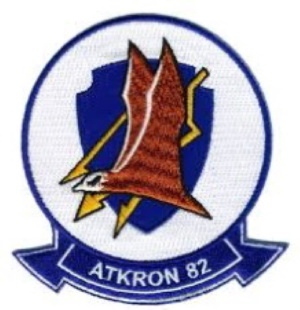 VA-82 Marauders
|
A7C Corsairs |
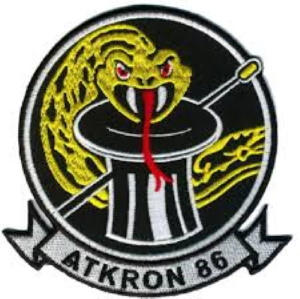 VA-86 Sidewinders
|
 A7C Corsairs |
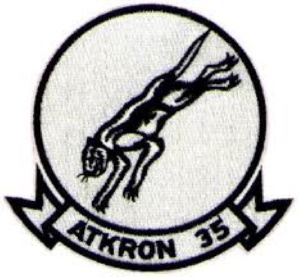 VA-35 Black Panthers
|
 A6A Intruders |
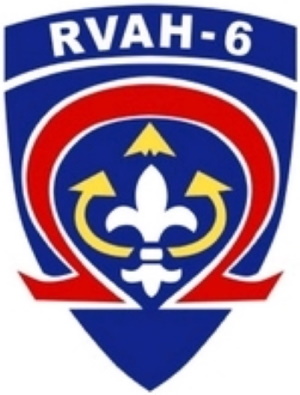 RVAH 6 Fleurs
|
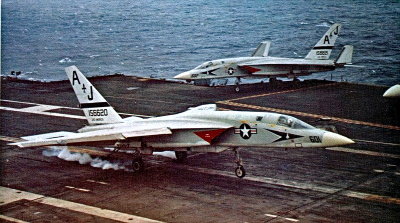 RA5C Vigilantes |
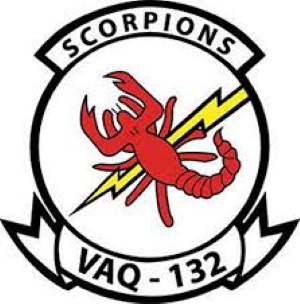 VAQ 132 Scorpions
|
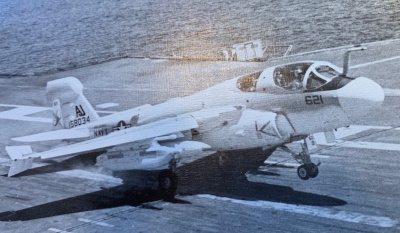 EA6B Prowlers |
 VAW 124 Bullseye Hummers
|
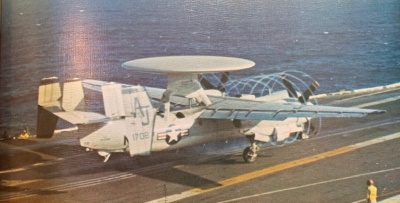 E2C Hawkeyes |
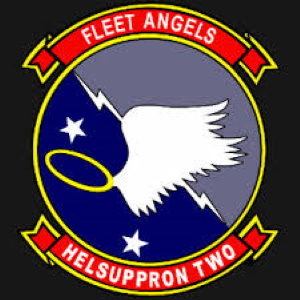 HC 2 Det 66
|
 SH3G Rescue Helicopters |
COD- Miss America
|
I flew off America to NAS Cubi Point on July 6th (Part of CAG 8 Fly Off)
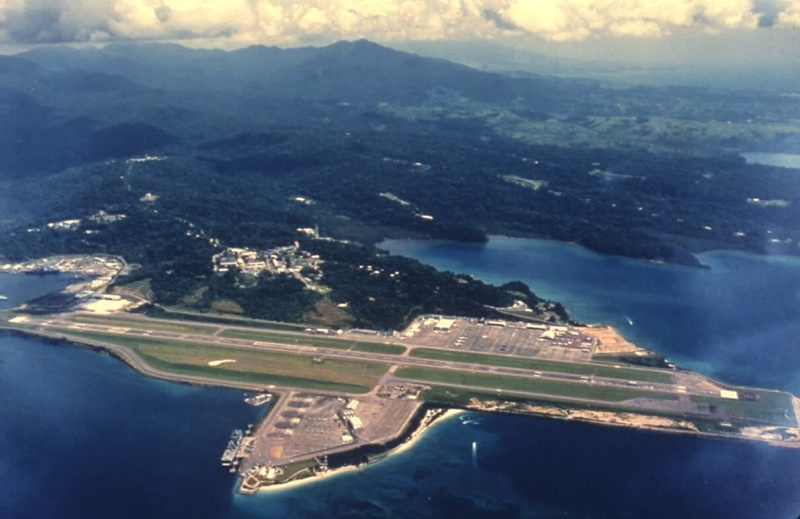 |
| The BOQ and Officer's Club were on the
hill just above the left third of the runway. |
The first thing to do was to get up the hill and get a room at the BOQ and then get a "Cubi Special" at the Cubi Bar.
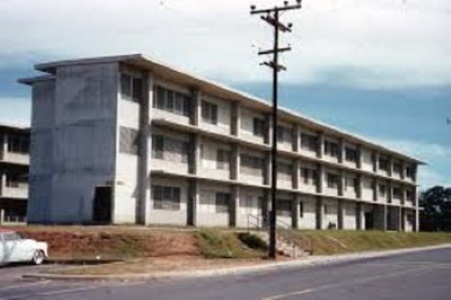 It was a short walk from the BOQ to the Cubi Point O'Club. |
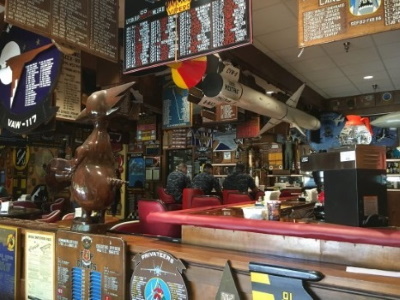 The Cubi Point Bar was famous and you could also get a good meal at the restaurant. |
We were only going to be inport Cubi for a few days. But, there was time enough for at least one trip
to Olongapo; to show the new guys "the ropes" of course!
 |
 |
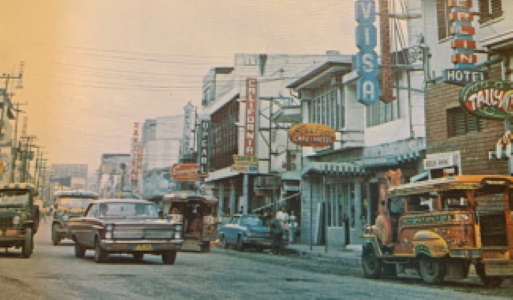 |
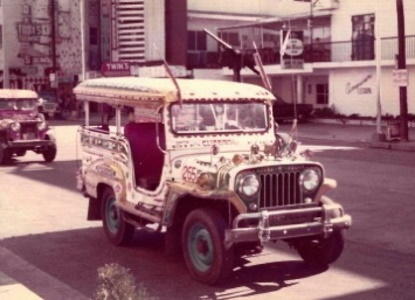 |
We most likely devoted one day and an overnight for Jungle Escape and Survival Training.
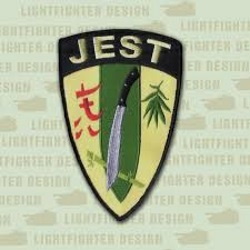 |
 |
On July 9th, I flew back on to America from NAS Cubi Point (Part of CAG 8 Fly On).
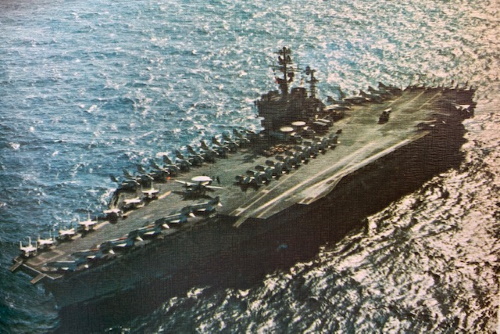 Photo from USS America 1972 Cruise Book
|
The America relieved the USS Coral Sea on Yankee Station on July 12th, 1972 It would turn out to be a very short line period! |
 |
| Photo from USS America 1972 Cruise Book |
My great
friend, Possum
Terrell, had
already been
out on Yankee
Station for
over a month.
Possum
came to Yankee Station
as the XO the VA 105
Gunslingers
onboard USS
Saratoga CVA-60. But the CO
of the VA 93
Ravens' on
USS Midway CVA 41
was shot
down
and Possum was
picked to
relieve him as
CO. So, Possum
was XO of VA 105
in the morning
and CO of VA
93 on the
afternoon of
June 12th. Possum
would remain
as CO of the
Ravens through
the end of the
war. He would
fly Iron
Hand missions
at night for
the B-52s during
President
Nixon's
Linebacker II which
would end the
air war!
We would fly missions in support of the Second Battle of Quang Tri.
 |
Most of these mission were in Quang Tri Province which is located in the north central region of South Vietnam between Hue City and the DMZ. Except for the narrow coastal plains, the terrain is dominated by hills and the Annamite Mountains in the west. |
 |
After the Battle of Khe Sanh in July 1968 , the camp was evacuated by the Marines. The North Vietnamese (NVA) continued their efforts to take over the entire Quang Tri Province. In 1972, the NVA were successful in capturing the town of Quang Tri (First Battle of Quang Tri). Quang Tri city and much of the lost territory in Quang Tri Province was retaken during the South Vietnamese (ARVN) from June through September 1972 (The Second Battle of Quang Tri). |
As
our squadron CO, CDR Scott lead the first
combat mission of the
deployment.
Flights recorded in my Logbook
 |
"The Stories of One Shot Scott" A great collection of sea stories taken from the naval career of Tom Scott Captain USN Ret. Copyright 2013 by Thomas P. Scott Create Space 2013 Amazon.com |
In his
book, "The Stories of One Shot Scott", CDR Scott
describes our squadron's first combat sortie and the level
of excitement in the ready room. Traditionally, the
sorties assigned the few days of a Vietnam deployment were
to relatively low threat area. In keeping with that
tradition, CDR Scott's mission was tasked to a "milk run"
near the DMZ. However, his "piece of cake" mission was
changed by the Forward Air Controller (FAC) to attack a
AAA site on Tiger Island, a much more exciting alternative. CDR Scott
tells his story on pages 125 through 128 of his book; a
great read!
Flights recorded in my Logbook
July 14th- 1.8 hours, 8 MK82s, CAS/DAS with FAC Nail 212 CAS= Close Air Support (troops in contact), DAS= Direct Air Support (suspected base camps)
July 14th- 1.8 hours, 10 Mk 82s, CAS/DAS with FAC Covey 82
Note: Covey FACs flew the OV-10 Bronco. It was a "fast mover" so could fly up to about 250 kts making it more difficult to hit with small arms fire!
July 15th- 2.1 hours, 6 MK 83, CAS/DAS, FAC Covey 86 (Ashaw Valley) I earned my 18th Strike Flight Air Medal on this flight
July 16th- 2.0 hours, 10 MK 82, CAS/DAS, FAC Tom 23
July 17th- 1.5 hours (1.5 hours night time), 10 MK 82s Pave Phantom flight*
Pave
Phantom Missions
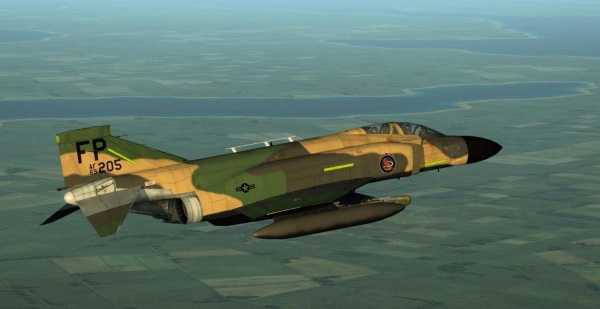 |
| USAF Pave Phantom F4D |
There
were actually two types of missions that involved the use
of USAF F4D aircraft; Pave Phantom and Combat Sky Spot.
Pave Phantom: On this type of mission, a specially configured F4D was fitted with AN/ARN-92 LORAN -D equipment. This type of aircraft, like the one pictured above, could be identified by a rather prominent white "towel-rail" antenna on the upper rear fuselage. The primary mission of Pave Phantom F4D aircraft was the seeding of the Ho Chi Minh Trail with sensors which required the precise nighttime navigational capability provided by LORAN. I expect that on occasion, these Pave Phantom configured aircraft were used in the "Combat Sky Spot" mission.
Combat Sky Spot: On this type of mission, remotely located ground radars were used to guide specially trained USAF aircrews to drop bombs at level high altitude based on verbal cueing and coordination between the aircrew and the radar site. Accuracy was in hundreds of feet. This mission was normally flown at night and targeted the Ho Chi Minh Trail. On these missions, our A7 aircraft would fly on either wing of the F4 and drop our bombs when the F4 crew dropped (both aircraft would be carrying the same type of bombs; MK 82 500# bombs).
I expect that the flights documented as Pave Phantom flights in the "Remarks" section of my log book were actually "Combat Sky Spot" missions as we delivered MK 82 bombs not "sensors".
Whatever the mission, on these flights a flight of two A7s would join up on the USAF F4D Phantom at some pre-briefed location such as a TACAN radial and distance). Each A7 would fly a loose parade position on each wing of the F4. The Phantom would be radar or LORAN controlled and bomb release was coordinated by USAF ground controllers. The target was usually a suspected NVA base camp, tunnel complex, or simple harassment along the Ho Chi Minh Trail. The Navy planes would carry the same type bombs as the Air Force F4D. We would release our bombs manually when we saw the bombs release from the F4D. The only issue for us was that we suspected that the Air Force was using a new type of electric fuse which had a bad habit of activating prematurely. I always briefed my wingman to break up and away from the F4 as soon as our bombs were released. We used manual fuses!
On one of these flights, I was on the left wing of the F4; my wingman was on the right. We broke up and away from the F4; electrically fused F4D bombs detonated prematurely destroying the aircraft probably killing the pilot and "back seater". No PRC-90 transmissions were ever heard or traces of the pilots discovered.
Neither of our aircraft received damage.
Back to flights recorded in my Logbook
July 17th- 2.1 hours, 10 Mk 82s, CAS/DAS, FAC Covey 75
July 18th- 2.3 flight hours, , combat tanker (1 point)
July 19th- 1.7 hours, 10 MK 82s, DAS, TACAN drop
July 19th- 2.2 hours, 10 MK 82s, DAS, TACAN drop
Note: TACAN drops involved dropping all our bombs in one run at a radial and distance from a TACAN. We presumed the target was NVA on the Ho Chi Minh Trail.
On June
20th, we began
flying
missions over
North Vietnam
At first, we did a couple of lower threat road reconnaissance flights (Road Recces).
July 20th- 2.1 hours, 10 MK 82s, Road Recce Route Package 2, Keep the airspeed about 450 kts and altitude above 3,000 to 4000'. Familiarize yourself with the
navigation and topography, look for trucks or carts moving on the roads or sampans on the waterways. Look for any small bridges
that have not been destroyed. Be careful to stay away from the SAM sites and AAA sites at Vinh.
July 20th- 2.1 hours, 10 MK 82s, Road Recce Route Package 3, Keep the airspeed about 450 kts and altitude above 3,000 to 4000'. Familiarize yourself with the navigation and topography, look for trucks or carts moving on the roads or sampans on the waterways. Look for any small bridges that have not been destroyed. Be careful to stay away from the SAM and AAA sites at Thanh Hoa and Ninh Binh.
At first, we did a couple of lower threat road reconnaissance flights (Road Recces).
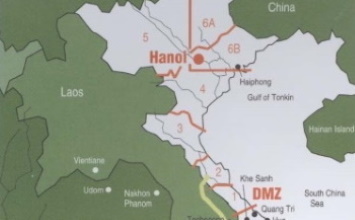 |
 |
July 20th- 2.1 hours, 10 MK 82s, Road Recce Route Package 2, Keep the airspeed about 450 kts and altitude above 3,000 to 4000'. Familiarize yourself with the
navigation and topography, look for trucks or carts moving on the roads or sampans on the waterways. Look for any small bridges
that have not been destroyed. Be careful to stay away from the SAM sites and AAA sites at Vinh.
July 20th- 2.1 hours, 10 MK 82s, Road Recce Route Package 3, Keep the airspeed about 450 kts and altitude above 3,000 to 4000'. Familiarize yourself with the navigation and topography, look for trucks or carts moving on the roads or sampans on the waterways. Look for any small bridges that have not been destroyed. Be careful to stay away from the SAM and AAA sites at Thanh Hoa and Ninh Binh.
OK, now that we have had a couple of "warm up combat flights", it's time to get on with it!
 |
July 21st-1.4 hours, 4 Mk 20 Rockeyes (expended), Flak Suppression Group Division Lead, Thanh Hoa Bridge Strike
The Mk 20 Rockeye consisted of a clam-shell dispenser containing 247 amour piercing shaped-charge bomlets.
Although it was designed to kill tanks and armored vehicles, it proved to be very effective against area targets
such as heavy AAA guns and their associated radar control vans.
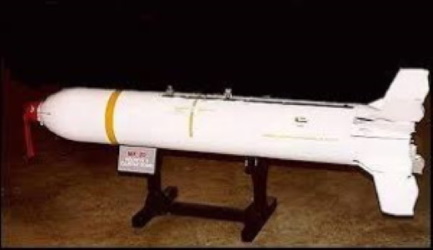 |
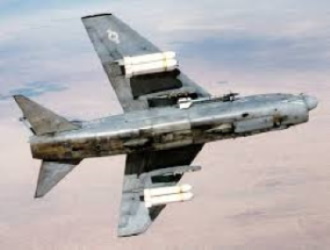 |
This was a great first strike for me because I had quite a bit of experience getting shot at from AAA sites around Thanh Hoa during my 1967 Vietnam deployment with VA-15 on the USS Intrepid during the summer of 1967. Of course they had increased the number of guns there during the Johnson bombing halt. There were many new manual 37 and 57 mm barrage fire AAA sites. And, I expected that they would have brought in some of the quad mounted 23mm rapid fire mobile gun systems. But, I was confident that they would still have the radar controlled 57 and 85 mm guns located on the approaches of the bridge especially where I have annotated the photo below with AAA. So, I had the known locations of those guns entered in my system so that I could toss my Rockeyes into that location if the guns had not started firing when I reached my roll in position. I had my other section concentrate their Rockeyes on the other side of the river.
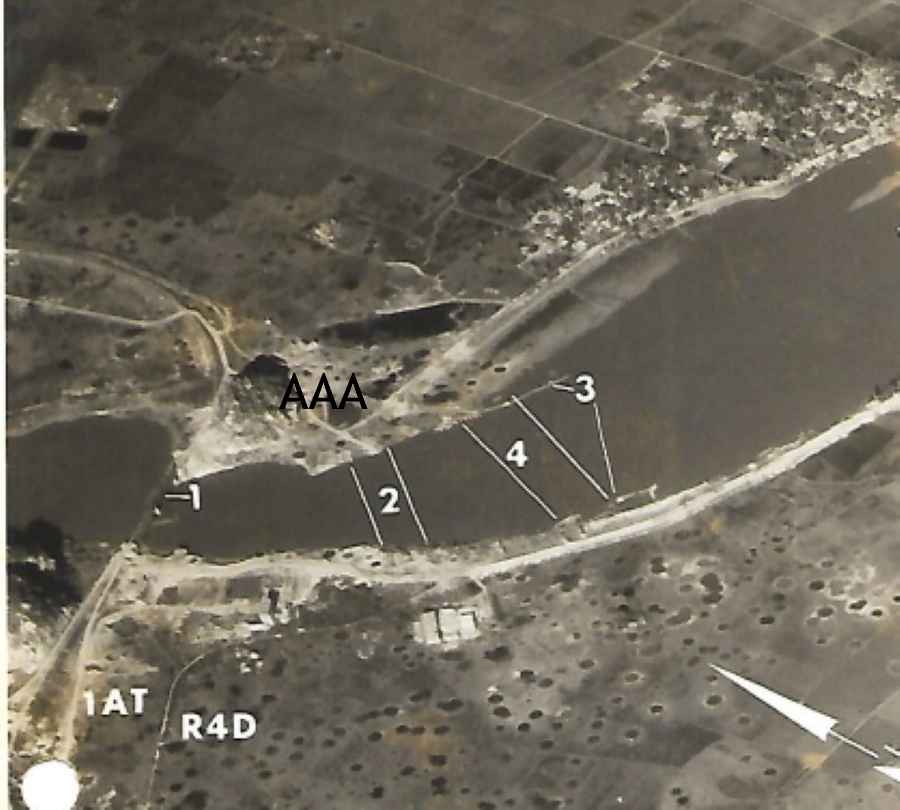 |
| I was not disappointed. My flak suppressor
section got several good secondaries as our
Rockeye bomblets found some ammunition. I expect
that there were some casualties among the gun
crews as well. And, I hoped that the projectiles
might have damaged some of the guns. |
July 22nd- 1.4
hours, 2
AGM 45 Shrikes
(not
expended), 2
MK 20 Rockeye
(expended),
Nam Dinh
Strike Iron Hand
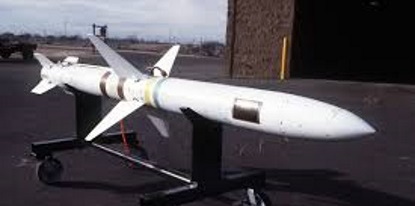 |
July 23rd-1.5
hours, 2
AGM 45 Shrikes
(expended), 2
MK 20 Rockeye
(not
expended),
Haiphong
Strike Iron
Hand
July 24th- 1.4 hours, 10 MK 82s, Hon Gay Barracks Division Lead
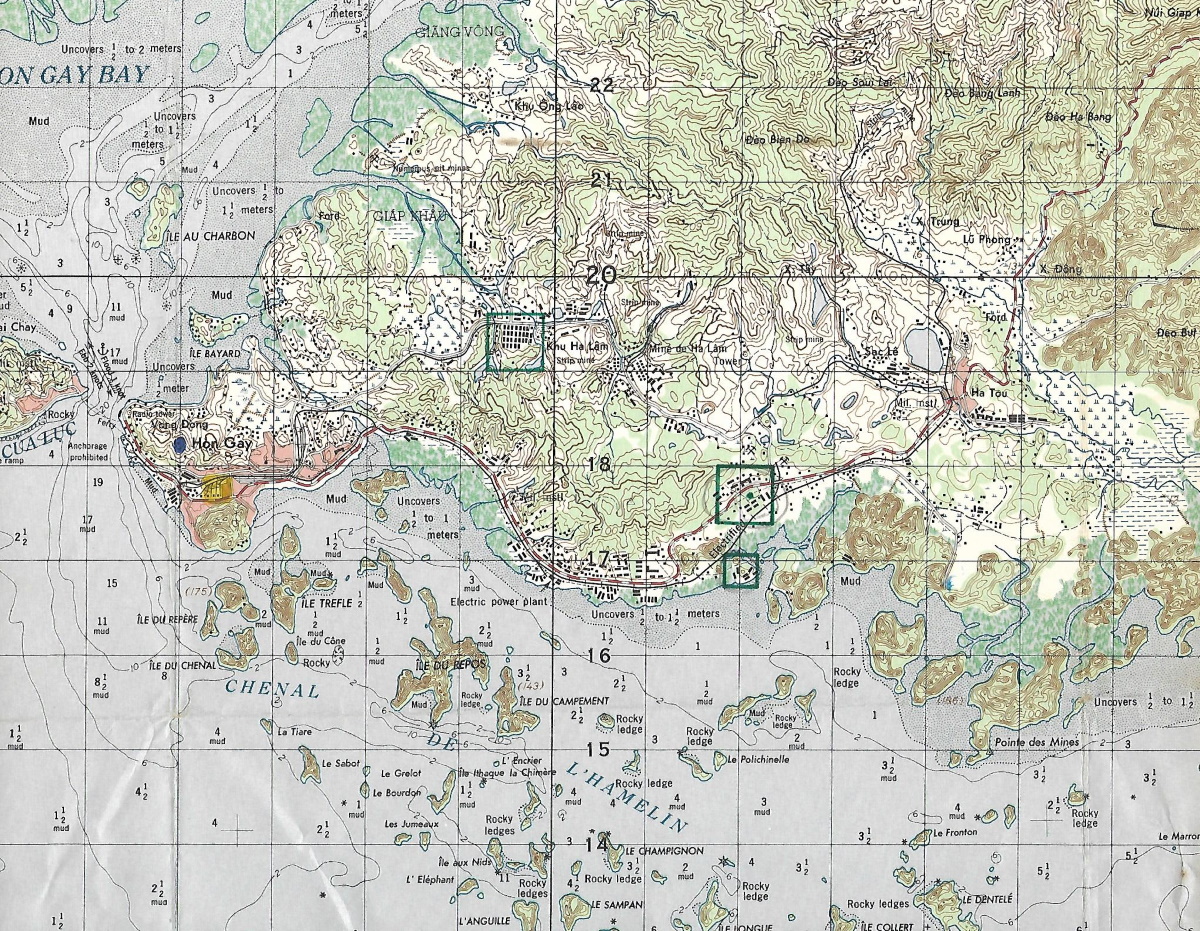 |
July, 1972
I flew 21 flights in July (38.2 hours) 5 non combat flights and 16 combat missions (219 total combat missions)
I logged 20 America traps (19 day, 1 night) for a cumulative total of America traps of 171.
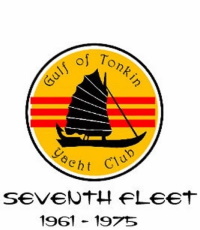 |
We really
hadn't earned
admission to
the Tonkin
Yacht Club
yet. But, We had flown some missions in Quang Tri in support of the ground forces there. We had flown some Pave Phantom missions. We had flown some low threat road recces in Route Packages 2 and 3. We had flown bomber, iron hand, and flack suppression missions in Route Packages 4 and 6B. We had a good warm up and had flown a few high threat missions without loosing any aircraft or pilots. We were ready for more challenging targets in Route Pack 6B! |
After only ten days on the line, the America experienced a ruptured main fuel pump which prompted an early return to
Naval Station Subic Bay for repairs. The repair work required two weeks to complete.
 Relationship of Naval Staion Subic Bay (bottom) and NAS Cubi Point (top) |
 |
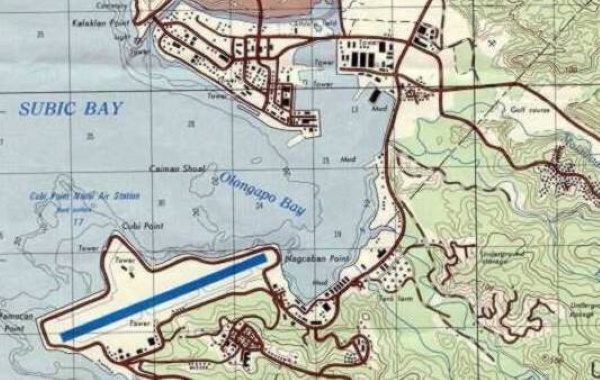 The crew
liked the location
of the America
alongside in Subic
Bay as it was
a short walk
to the
Enlisted and
Chief's
Clubs and the
gate to
Olongopo. The
pilots however
preferred the
Cubi BOQ and
the Cubi
O'Club which were
a taxi
ride from the
ship and the
main gate
to Olongopo.
|
Two
weeks in Subic
Bay/Cubi Point
would
challenge the
endurance of
the most dedicated
liberty hound!
No one could handle two weeks of Olongapo liberty.
No one could handle two weeks of Olongapo liberty.
| If you want to
see a good
depiction of
Olongapo
liberty, watch Steven Coontz's "Flight of the Intruder" movie. It actually combines the antics of the Cubi Point O'Club carrier arrestment activity with the atmosphere of Paulines' liberty in Olongapo including crocodile feeding. |
| Actually,
I discovered
the the
Marmont Hotel
just on the
other side of
the bridge
which had an
excellent
restaurant. I visited
it often! |
 |
| Those sailors on the
left side of
the image were
probably not
returning from
the Marmont;.
It was more
likely they
were returning
from bars like
Paulines! |
Besides
the Marmont in
Olongapo,
there were
lots of good
places to eat
on base. Both
the Cubi Point
and Subic Bay
Officer's
Clubs had
excellent
restaurants.
Subic also had
a place called
the 'Chuck
Wagon' which
had good barbeque.
If you were
lucky enough
to meet a
Philipino
family and
were invited
to join them
for a home
cooked meal,
you were in for
a treat. To
this day, I am
disappointed
if I go to a
Navy reception
and they don't
serve lumpia!
For some reason, I didn't play tennis in WESTPAC. I did play some golf though at the Subic Bay Golf Club.
For some reason, I didn't play tennis in WESTPAC. I did play some golf though at the Subic Bay Golf Club.
 |
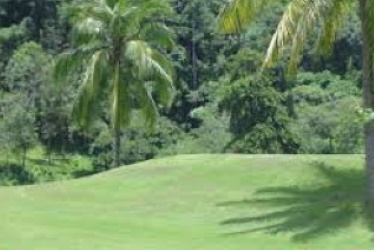 |
This golf course was magnificent. It had lots of relief change from tee to green and jungle rough.Players were required to have personal Philippino caddies. Players were prohibited to go into the jungle to retrieve a lost ball due to the danger from poisonous bamboo snakes. The caddies did that. They always found your ball or a reasonable facsimile of your ball.
Or, you could go out to the Grande Island Recreation area in Subic Bay and go swimming or just relax on the beach.
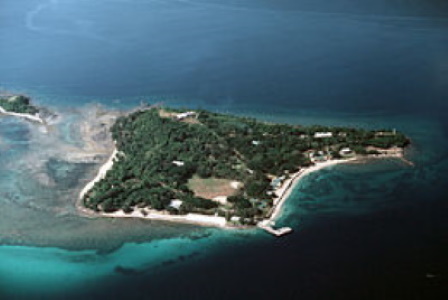 |
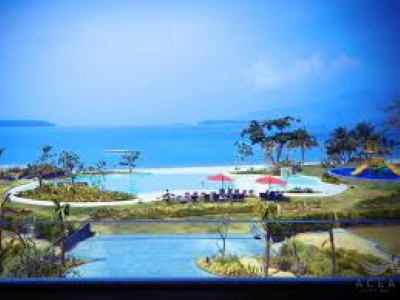 |
Or, you could go to Manila
 |
In 1972, a great place to stay and hang out was the Army Navy Club Hotel pictured here. It has since been renovated and is now the Rizal Park Hotel |
When I was in Manila, I enjoyed watching the Jai Alai while drinking San Miguel beer.
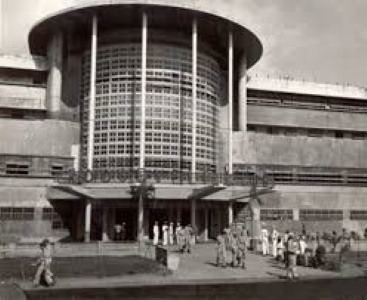 |
 |
Or, you could travel north to the mountains of Baguio and play golf or go horseback riding.
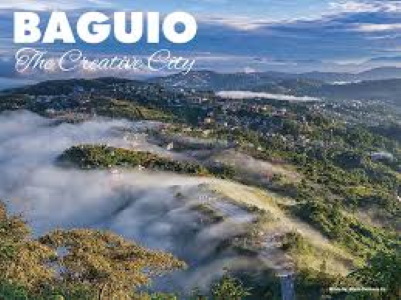 |
 |
With the feed pump repairs complete, the America finally got underway on about August 8th to return to the line.
August, 1972
I flew 19 flights in August (35.1 hours); 2 non combat flights and 17 combat missions (234 total combat missions)
I logged 18 America traps (11day, 7 night) for a cumulative total of America traps of 189
August
9th- 0.4
hours, a
short non
combat flight
from America
back to Cubi
Point for some
reason August
9th- 0.4
hours, a
short non
combat flight
from Cubi
Point back to
America.
Our
Second
Line
Period
(August 8th
through August
30th)
August 17th- 2.4 hours, 6 MK 82s, Mership Recce 20th Strike Flight Air Medal
August 18th- 1.9 hours, 5 MK 46 Destructor Mines, 5 MK 82s, Vinh, 2 SAMs fired
August 19th- 1.3 hours, 10 MK 82s, Hong Gay Barracks Division Lead (My 2nd flight to to the Hon Gay barracks)
The A7 Night Terrain Following Radar (TFR) Night Capability
August 22nd- 2.4 hours, 4 MK 82s, 2 MK 20 Rockeyes, night Mership Recce
August 23rd- 2.0 hours, 9 Mk 82s, 2 MK 20 Rockeyes, night 6B recce 230th combat mission
August 24th- 1.8 hours, 10 MK 82s, Division strike lead on the Xom Tuai Highway bridge.
August 25th- 2.3 hours, 9 MK 82s, 2 MK 20 Rockeyes, night 6B recce
August 26th- 1.7 hours, 4 MK 82s, 2 Mk 20 Rockeyes, night MRSHIP recce with Owl 15
August 27th- 2.0 hours, 10 Mk 82s, Division lead- Vinh petroleum storage area (fuel tanks), secondary explosions
My logbook records that I did not fly any combat missions from August 28th through September 5th (7 days).
Whenever we had a stand down break, we used the time for the time honored tradition of marking a centurion (100 traps) achievement
or milestone such as accident free period of operations with the traditional cake!
These
images were
colorized by
Ray Thomas
using Photo
Shop Elements
2020
software
The requirement for five carriers assigned to Yankee Station during Linebacker stressed the number of available personnel. To fill the void, the Navy lowered the requirement for enlistment.
Low quality replacement junior enlisted personnel !!!
Inport Cubi Point from September 1st through September 5th
Cdr Sumner relieved Cdr Tom "Hook" Scott in Hangar Bay One on September 2nd, 1972
CDR Breast brought much needed combat experience to the squadron and the air wing! Cdr Breast was a graduate of the Navy's Test Pilot School who had worked extensively with the testing of the AGM 62 Walleye TV guided air to ground missile. He was an experienced combat pilot with VA--163 which was part of CAG 16 onboard USS Oriskany in 1966 and 1967. He earned a Silver Star as part of a six plane strike with Walleye missiles against the Hanoi Thermal Power plant on August 21st, 1967. He was also awarded additional DFCs and Air Medals on that tour and while flying with VA-163 onboard the USS Hancock in 1968 and 1969.
Having just completed a busy month in August with 19 flights (35.1 hours) and 17 combat missions,
we were headed for an even busier September.
Back to
Quang Tri for
a couple of
days!
August 11th- 1.9 hours, 10 MK 82s, CAS/DAS, FAC Tum 23 August 12th- 2.6, 4 Kk 82s, 2 MK 20 Rockeyes, Merchant Ship Surveillance with Lauredo 17
MERSHIP Missions
Normally MERSHIP Missions were a relatively routine mission. But, Gary Tabbert has a"sea story" about a MERSHIP mission that he flew on that was not "routine". I'll insert his story as soon as he gives me the details.
Back up North!
August
15th- 2.1
hours, 4
MK82s, 4 MK 20
Rockeyes,
Night Road
Recce August
16th- 2.0
hours, 4 Mk
82s, 4 Mk 20
Rockeyes,
Night Road
Recce August
17th- 1.9
hours, 4 MK
82s, 4 MK 20
Rockeyes,
Night Road
Recce
August 11th- 1.9 hours, 10 MK 82s, CAS/DAS, FAC Tum 23 August 12th- 2.6, 4 Kk 82s, 2 MK 20 Rockeyes, Merchant Ship Surveillance with Lauredo 17
MERSHIP Missions
| MERSHIP Missions stand for
Merchant ship reconnaissance missions. These
flights of two aircraft under the control of a
surface radar from a ship or aircraft (in this
case Laurado 17) would direct the MERSHIP
mission A7s to investigate unknown surface
ship contacts, identify them if possible and
engage them them if they met the 'Rules of
Engagement" guidelines. The MK 20 Rockeye was
the perfect weapon for the initial attack that
was moving as it was an area weapon and it's
bomlets were capable of penetrating eight
inches of steel. The MK 82s were an excellent
weapon for a ship that had lost its propulsion
and was "dead in the water". Note: P3s were the normal airborne asset used for the MERSHIP mission. |
Normally MERSHIP Missions were a relatively routine mission. But, Gary Tabbert has a"sea story" about a MERSHIP mission that he flew on that was not "routine". I'll insert his story as soon as he gives me the details.
Back up North!
August
13th-
1.7hours,
Walleye, Vinh,
bad weather,
My 220 mission
August 14th, 2.2 hours, 5 MK 83s, Thanh Hoa Sam Site
I was awarded my 7th NCM for this mission
August 14th, 2.2 hours, 5 MK 83s, Thanh Hoa Sam Site
I was awarded my 7th NCM for this mission
I was
awarded my 7th
NCM for this
mission.
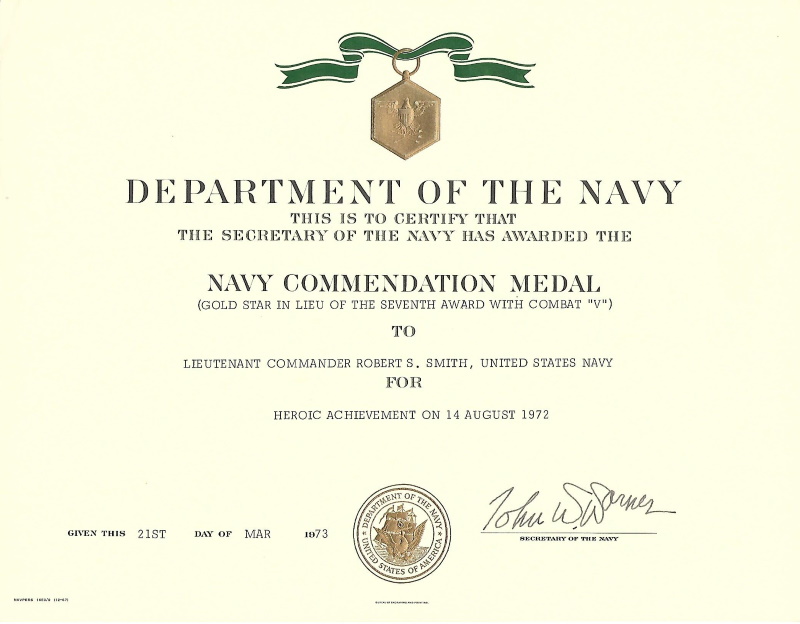 |
 |
Yankee
Station
Aircraft
Carrier Operating
Hours
| There were two type of
operating hours for Yankee Station carriers: Two carriers flew from 7 in the morning to 7 at night so that two carrier airwings were available to execute daytime major strike packages. One carrier flew from7 at night to 7 in the morning to cover the night A6 low level strikes, A7 night recce, and F4 Phantom night BARCAP (Barrier Combat Air Patrol) requirements. If there was a forth carrier available, it normally flew the 7 am to 7 pm schedule except for special circumstances such as the Linebacker 2 night B-52 strikes to Hanoi in December when two carriers flew the night schedule. |
Back
to flights
recorded in my
Logbook
August 17th- 2.4 hours, 6 MK 82s, Mership Recce 20th Strike Flight Air Medal
August 18th- 1.9 hours, 5 MK 46 Destructor Mines, 5 MK 82s, Vinh, 2 SAMs fired
August 19th- 1.3 hours, 10 MK 82s, Hong Gay Barracks Division Lead (My 2nd flight to to the Hon Gay barracks)
 |
| I don't have much more
information about this mission except this
cart showing the barracks complexes which
existed when this map was made! |
Night
Missions over
North Vietnam
| Our
"normal"
A7 night recce missions were flown at medium to
high altitudes away from any low altitude AAA
including the ZSU 23-4. When we saw a
target, we would usually use the computed toss
delivery which would keep us out of harms
way. When I think about flying night recce flights, I think about Seven Coontz' "Flight of the Intruder". You would always know the route where those 500 ft low level single night A6 were flying. All you had to do was look down at the trail of low level AAA shooting at the A6 all the way to and from the target. Luckily, most of the manually fired AAA was usually a bit behind the A6 which was flying about 450 kts. |
The A7 Night Terrain Following Radar (TFR) Night Capability
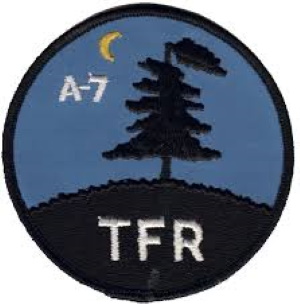 A7 TFR Patch
|
I
remember seeing some of the VA-174 instructor
pilots wearing A7 TFR patches on their flight
suits or flight jackets. But, I don't recall
flying any dedicated terrain following radar
flights in the RAG curriculum. We did some
familiarization flights with the APQ-126 radar
and some night flying but no real emphasis on
using the radar in conjunction with the
inertial navigation system and radar altimeter
on any night low level training flights. During our VA-82 squadron workup before deployment, there wasn't any significant effort directed toward developing the skills required to gain the level of expertise required in night radar system navigation, radar target recognition, and systems weapons delivery required to safely fly the mission in combat. The demands on the pilot of a single seat airplane were simply too high to fly this type of mission, especially in a combat environment. We had other light attack skills that took priority. |
Night
low level terrain following navigation and radar
systems weapons delivery was the domain of the two
seat A-6 Intruder. In the Intruder, the pilot
and bomber navigator (BN) could share the
load; the BN was primarily responsible for
navigating, radar target recognition, weapons delivery
while giving the pilot warning of radar controlled
SAMs and AAA while pilot kept his eyes on the
flight instruments, visual AAA and SAM detection, and
evasive maneuvering required in a combat environment.
August 20th- 2.1 hours, 4 MK 82s, 2 Mk 20 Rockeyes, Night Recce, 3 SAMs fired (wingman-Jim Kuzmick)
Apparently some "hot shot staff type on the flag staff told the Admiral that the A7E had a TFR capability which resulted in my being scheduled for a night mission in Route Package 6B with Jim Kuzmick as my wingman. I don't recall whether we were expected to fly an A6 Intruder type low level profile to a pre-briefed radar significant target or whether it was a road recce mission. I assume it was the later because I am am confident that CDR Scott as Commanding Officer and my roommate Snuffy Smith as Operations Officer would have never signed off on our being scheduled for an A6 type mission. The A7 had a marginal capability at best compared to the A6 and we did not have the training to safely execute the night low level TFR mission.
I don't remember which type of mission we briefed in the preflight brief. But, I do remember briefing a navigation route that had some radar significant turn points while keeping our route relatively free from flying over any concentrations of SAM and AAA sites, as least as well as was possible in Route Pack 6B. I'm sure we used medium altitude tactics. We would not have used low altitude tactics as we were not trained for them.
I do remember vividly that not long after going feet wet at the coast, I saw the track of a single A6 low level level flight enroute to a Hanoi area target. It was not difficult watching his progress; just watch the AAA. Not long after, we saw a SAM lift off probably twenty miles away or so. But, at night, it looked as if it was just off our nose. Our EW gear told us that we were not the target. But, it sure got our attention! As we progressed along our route, we were engaged by two SAMs. We were the target this time. After maneuvering to avoid the SAMs, I turned the flight back around toward the coast and Jim and I dropped our bombs on a bridge that was one of our secondary targets.
Back to my
Logbook EntriesAugust 20th- 2.1 hours, 4 MK 82s, 2 Mk 20 Rockeyes, Night Recce, 3 SAMs fired (wingman-Jim Kuzmick)
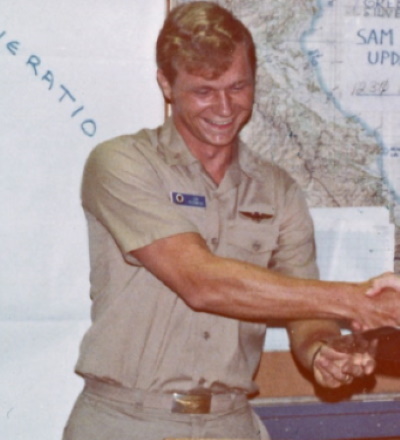 Jim Kuzmick
|
Apparently some "hot shot staff type on the flag staff told the Admiral that the A7E had a TFR capability which resulted in my being scheduled for a night mission in Route Package 6B with Jim Kuzmick as my wingman. I don't recall whether we were expected to fly an A6 Intruder type low level profile to a pre-briefed radar significant target or whether it was a road recce mission. I assume it was the later because I am am confident that CDR Scott as Commanding Officer and my roommate Snuffy Smith as Operations Officer would have never signed off on our being scheduled for an A6 type mission. The A7 had a marginal capability at best compared to the A6 and we did not have the training to safely execute the night low level TFR mission.
I don't remember which type of mission we briefed in the preflight brief. But, I do remember briefing a navigation route that had some radar significant turn points while keeping our route relatively free from flying over any concentrations of SAM and AAA sites, as least as well as was possible in Route Pack 6B. I'm sure we used medium altitude tactics. We would not have used low altitude tactics as we were not trained for them.
I do remember vividly that not long after going feet wet at the coast, I saw the track of a single A6 low level level flight enroute to a Hanoi area target. It was not difficult watching his progress; just watch the AAA. Not long after, we saw a SAM lift off probably twenty miles away or so. But, at night, it looked as if it was just off our nose. Our EW gear told us that we were not the target. But, it sure got our attention! As we progressed along our route, we were engaged by two SAMs. We were the target this time. After maneuvering to avoid the SAMs, I turned the flight back around toward the coast and Jim and I dropped our bombs on a bridge that was one of our secondary targets.
More
About Jim Kuzmick
 Picture from USS
America 1972 Cruise Book
|
This is Jim Kuzmick entertaining the sailors onboard USS America in Hangar Bay One during our 1972 Vietnam deployment with James Taylor and Simon & Garfunkle tunes. I also remember Jim playing in one of the Olongapo bars (Jim says that he does not remember doing this!). However, I think I remember enjoying a beer or two while listening to Jim entertain there. The Philippine entertainers enthusiastically surrendered the stage to "Kuz" because they enjoyed listening to Jim's folk music. Jim learned a lot of folk music while in college at Princeton from some of his classmates. He had a rock band at Princeton and he hitch-hiked across the country in 1966 playing folk & blues in various "joints". He also had a rock band during flight training with several Naval Academy grads. But, he says that his favorite memories were playing for the large crowds of sailors on the America during stand down days. Jim and I share the same James Taylor favorites; "Fire and Rain" and "Sweet Baby James". |
August 22nd- 2.4 hours, 4 MK 82s, 2 MK 20 Rockeyes, night Mership Recce
August 23rd- 2.0 hours, 9 Mk 82s, 2 MK 20 Rockeyes, night 6B recce 230th combat mission
August 24th- 1.8 hours, 10 MK 82s, Division strike lead on the Xom Tuai Highway bridge.
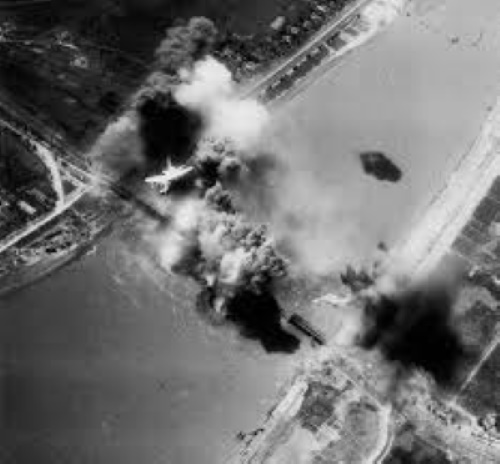 |
| I have no idea if this
a picture from this strike. It's just a great picture of an A7 pulling off after direct hits on a bridge! |
August 25th- 2.3 hours, 9 MK 82s, 2 MK 20 Rockeyes, night 6B recce
Night Post
Mission
Refueling
| Usually flights which
lasted more than 1.8 or 1.9 hours would
require airborne refueling on the way back
to the ship from the mission A6 tanker the
A7 recovery tanker. Night 6B recce
missions where you were shot at by AAA or
SAMs, followed by night refueling on the
way back to the ship, and ending with a
night carrier landing were missions where
you more than earned your flight pay. |
Back to
flights
recorded in my
Logbook
August 26th- 1.7 hours, 4 MK 82s, 2 Mk 20 Rockeyes, night MRSHIP recce with Owl 15
August 27th- 2.0 hours, 10 Mk 82s, Division lead- Vinh petroleum storage area (fuel tanks), secondary explosions
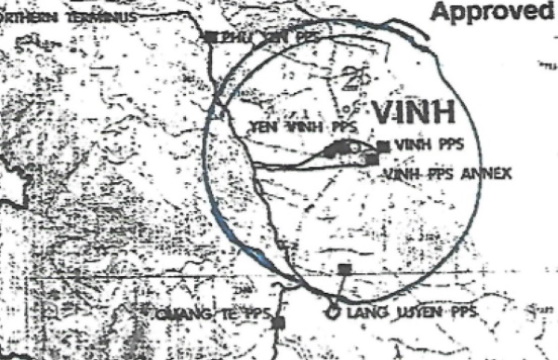 |
 |
I was awarded my 8th NCM for
this mission
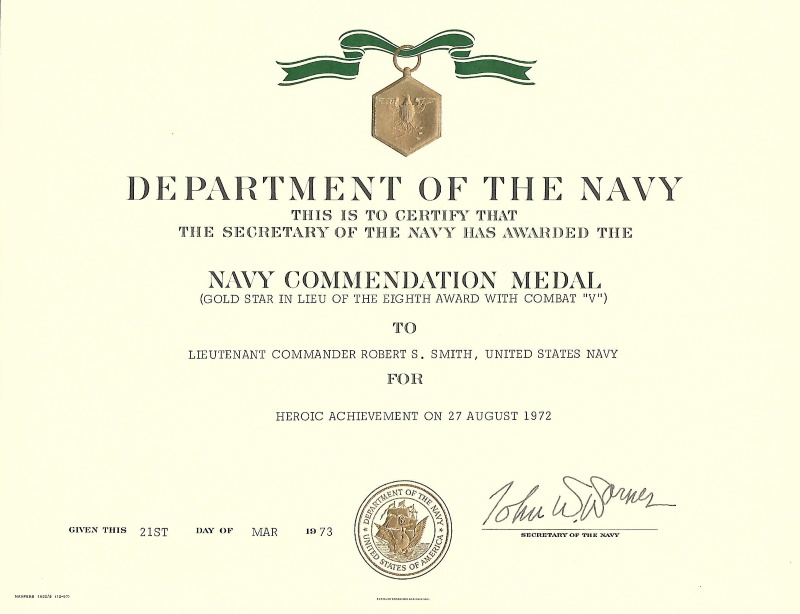 |
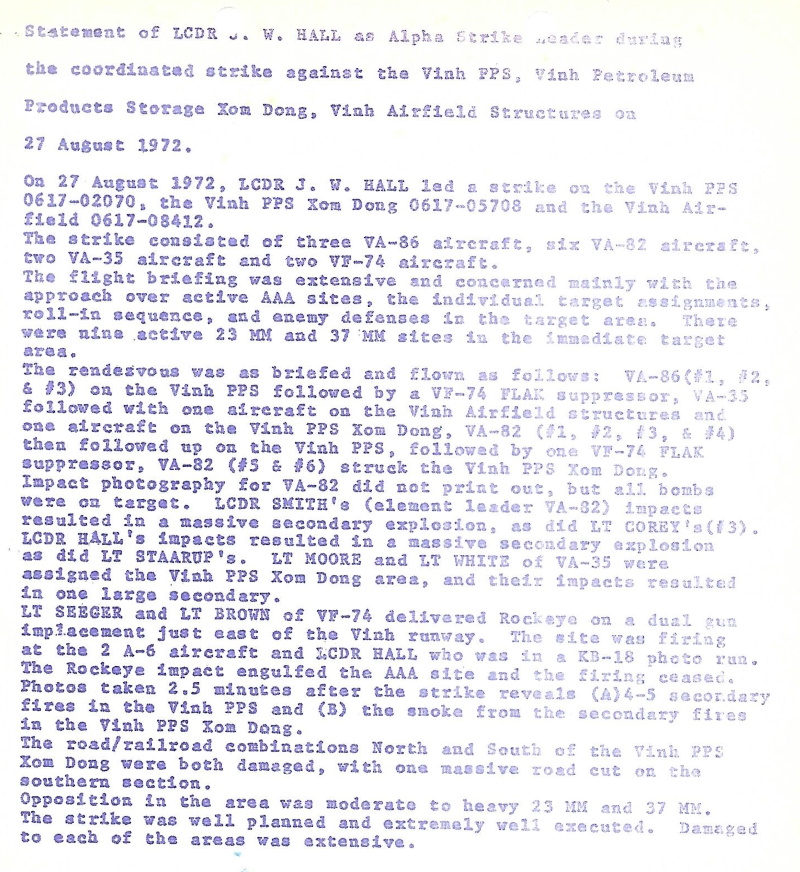 |
| I was the VA-82
element leader with six bomber aircraft as
part of this major strike lead by LCDR Jim
Hall, Operations Officer VA-86. The only
VA-82 pilot recommended for the NCM
besides myself (credited with a "massive
secondary explosion") was my section
leader (#3), Bob Corey who was also
credited for the other "massive secondary
explosion". Of course our wingmen's bombs
may also been responsible for the
secondaries but they were not recommended
for any awards. |
My logbook records that I did not fly any combat missions from August 28th through September 5th (7 days).
Whenever we had a stand down break, we used the time for the time honored tradition of marking a centurion (100 traps) achievement
or milestone such as accident free period of operations with the traditional cake!
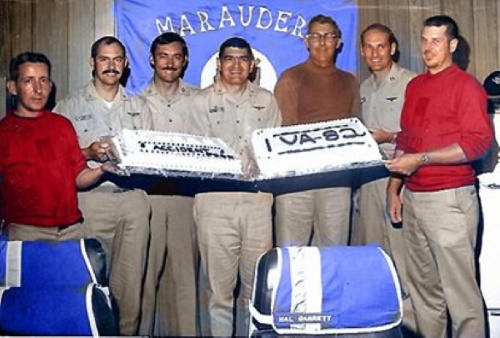 |
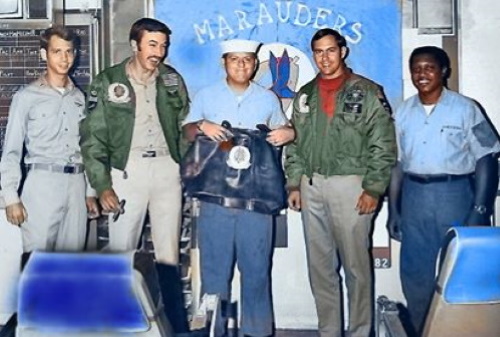 |
| From left to right: WO1
John Young, me, Charlie Sapp. CDR Tom Scott
CO, Master Chief Moorehead, LT Bruce
Page,unknown maintenance CPO |
Left to right: Ltjg Jim Brister, Lt Al Schwark, AMH1 Rothensberger, me, and PR1 Jackson |
| This cake ceremony actually took place in the ready room on June 15th during the transit from Norfolk to Cubi Point. | It was traditional to present a parachute bag or similar bag to a departing pilot. This one actually conducted at the end of the 1971 Med cruise was presented to LT Al Schwarkl |
Post
Script: I was
given a VA-82
garment
bag similar to
the one in the
right picture
to use when flying an
aircraft on a
"cross
country"
flight. Somehow, I
lost track of it
sometime after I left
VA-82. A
few years ago,
I was
contacted by a
"good
Samaritan" who
had purchased
my parachute bag on
E Bay. He know
it was mine
because my leather name
tag was on it and he
found me on
Google. He
returned to me
refusing
payment!"Thank you
for your
service" was
his reply.
I'll use
this opportunity
to relate
problems we
had with
enlisted
manning during
this
deployment.The requirement for five carriers assigned to Yankee Station during Linebacker stressed the number of available personnel. To fill the void, the Navy lowered the requirement for enlistment.
Low quality replacement junior enlisted personnel !!!
| Although essential
personnel had their enlistments extended
while on Yankee Station, junior enlisted
personnel who departed the squadron needed
to be replaced. But with the increased
tempo of operations in WESTPAC, aircraft
carriers, surface ships,and squadrons all
needed replacement junior enlisted
personnel. The problem was with anti-war
fever rampant in the states, enlistment
rates were down. To solve the problem, entry qualification standards were lowered or ignored. One of those standards which was lowered was the requirement to be a high school graduate or at least have a GED. Another standard which was lowered or ignored was intelligence test scores. Many new personnel showing up in WESTPAC had IQ ratings below 100; some as low as 80. My policy as Maintenance Officer was to greet all new first enlistment personnel assigned to the Maintenance Department. I would normally do this in the ready room when there was a break of some kind. I remember clearly talking with a group of 15 to 20 new arrivals in the ready room. I discussed how the Maintenance Department worked onboard the carrier and how each of them would spend some time on temporary additional duty (TAD) with the ship as mess cooks or compartment cleaners. Some of would go TAD right away and then be assigned to the Line Division. Others would go to the Line Division first and then TAD. I explained that the Line Division provided plane captains for the aircraft performing preflight inspections, engine start and systems checks on the flight deck. I explained that the flight deck during flight operations was dangerous place and that each new guy had to take his training seriously. I remember looking out at this new group while I explained what was required of personnel on the flight deck. There was nothing but blank stares. The lights were on but nobody was home. Out of that entire group we were able to get only one guy who we felt could safely be assigned to the flight deck. The others either got repeated TAD assignments or worked in other non flight deck assignments. That one guy was something special though. He came from a tough neighborhood in south Philly or east St Louis; someplace like that. His IQ was a bit under 100. But, he had goals; to serve his country and to gain skills. We assigned him to the Line Division. He became interested in becoming a jet mechanic. He studied his courses with help from his Line Division petty officers became a designated striker; ADJAN (E3). Before I left the squadron in December, he had been advanced to Petty Officer Third Class ADJ3 (E4). Everyone involved was very pleased with his accomplishment! |
Race riots
onboard
America and
other ships !!
| Another serious
problem with these new recruits was that
some of them were gang members and had
little or no interest in performing their
tasks as airman, seaman, or fireman
recruits. Instead, they roamed around the
ship in groups making life difficult for
the motivated sailors who were trying to
do their jobs. There were scuffles,
assaults, robberies, etc. There were places on America on the second deck and below, especially around the mess decks that I avoided. I spent most of my time on the hangar deck or above. I was too busy with planning or flying missions to spend any time hanging around on the mess deck. The problem was resolved quickly though. I don't know if the trouble makers were sent back to the states and discharged or whether the pace of operations was so intense in September and October that we pilots could only concentrates on planning and flying combat missions. Perhaps the chiefs took care of the problem. By the end of the war for the carriers in late December or early January, the emergency lowering of enlistment standards returned to reasonable levels and the trouble makers were gone from the Navy. |
Inport Cubi Point from September 1st through September 5th
Cdr Sumner relieved Cdr Tom "Hook" Scott in Hangar Bay One on September 2nd, 1972
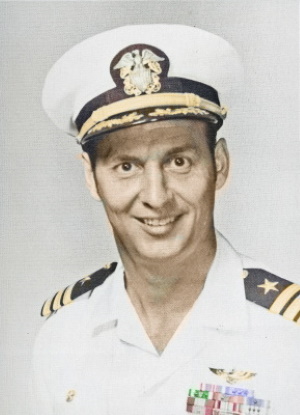 |
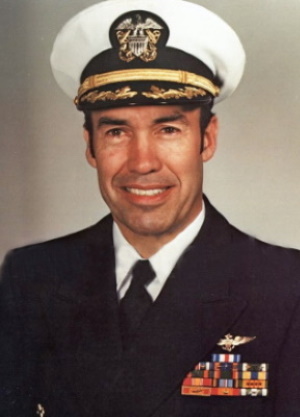 |
| CDR Don Sumner | CDR J "Felter" Breast |
CDR Breast brought much needed combat experience to the squadron and the air wing! Cdr Breast was a graduate of the Navy's Test Pilot School who had worked extensively with the testing of the AGM 62 Walleye TV guided air to ground missile. He was an experienced combat pilot with VA--163 which was part of CAG 16 onboard USS Oriskany in 1966 and 1967. He earned a Silver Star as part of a six plane strike with Walleye missiles against the Hanoi Thermal Power plant on August 21st, 1967. He was also awarded additional DFCs and Air Medals on that tour and while flying with VA-163 onboard the USS Hancock in 1968 and 1969.
Having just completed a busy month in August with 19 flights (35.1 hours) and 17 combat missions,
we were headed for an even busier September.